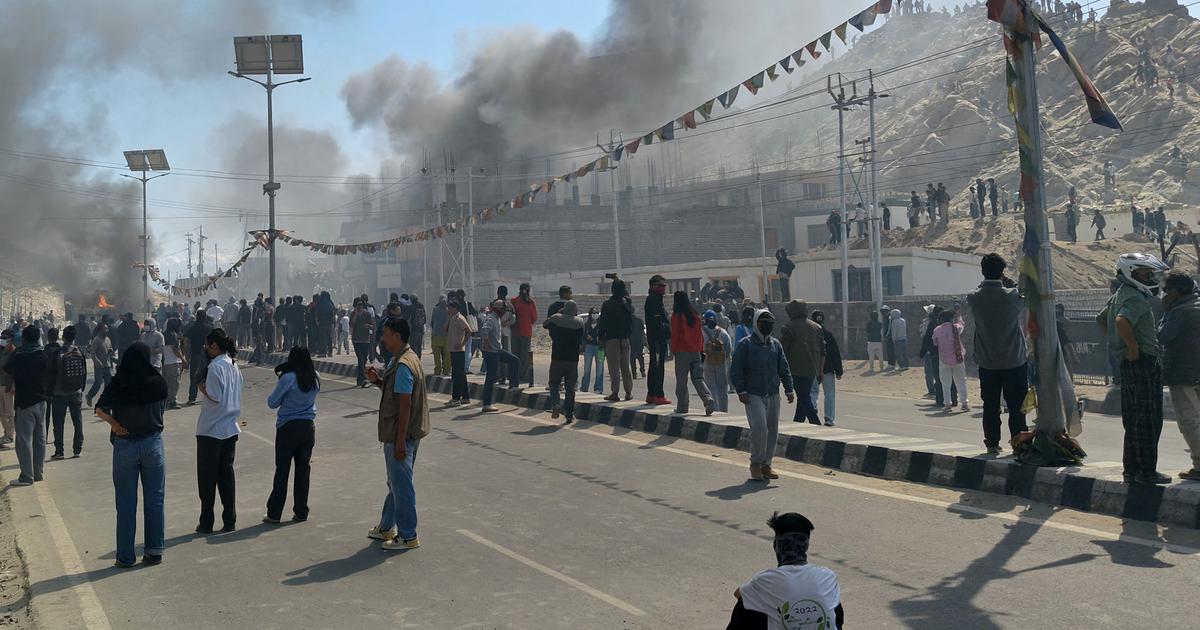Clashes Erupt in Leh Amid Growing Statehood Demands
Authorities in Ladakh have imposed a strict curfew in the union territory’s capital, Leh, after violent clashes between demonstrators and security forces left at least four people dead and dozens injured. The unrest marks one of the worst outbreaks of violence in the Himalayan region in decades.
On Wednesday, protesters demanding full statehood for Ladakh and greater job opportunities for locals set fire to the ruling Bharatiya Janata Party’s (BJP) district office and torched a police vehicle. Security forces responded with bullets and tear gas to disperse the crowd.
Anger Over Statehood and Autonomy

Ladakh, home to nearly 300,000 people, has been at the heart of political debate since 2019, when the Indian government revoked Jammu and Kashmir’s special status and carved Ladakh out as a separate union territory under direct federal control.
The move stripped Ladakh of its limited autonomy, sparking fears among residents of cultural erosion, loss of land rights, and limited job opportunities. While Leh’s Buddhist-majority community had earlier advocated separation from Kashmir, both Leh and Muslim-majority Kargil have since united in demanding restoration of statehood and constitutional safeguards.
Protests have been ongoing for months, but Wednesday’s violence was unprecedented in scale and intensity.
Government Blames Activist, Protesters Deny Allegations

India’s federal home ministry accused well-known activist and climate campaigner Sonam Wangchuk of fueling the unrest through “provocative” speeches, likening the demonstrations to international protest movements such as the Arab Spring. Officials alleged that his remarks misled local youth and escalated tensions.
Wangchuk, who had been on a hunger strike since 12 September, strongly denied the accusations. Shortly after the clashes, he ended his fast and urged demonstrators to maintain peace.
“Our movement has always been peaceful. Violence only weakens our cause,” Wangchuk said, stressing that widespread frustration among unemployed youth, rather than deliberate incitement, had driven people onto the streets.
Rising Frustration Among Youth
Local leaders and civil society groups echoed concerns over the federal government’s slow response to Ladakh’s demands.
Padma Stanzin, one of the strike organizers, told the media that people felt their voices were being ignored. “We had no idea things would escalate this way. The people of Ladakh are desperate for dialogue, but repeated delays have only deepened resentment.”
Chhering Dorje Lakrook, president of the influential Ladakh Buddhist Association, added that while the region’s youth reject violence, anger has been growing due to lack of employment and delays in government talks. “People are losing patience. Promises have been made, but concrete results are missing,” he said.
Security Forces Under Scrutiny
The home ministry confirmed that security personnel opened fire “in self-defense,” which led to the reported deaths. More than 30 police officers were injured during the clashes. Rights groups, however, have criticized the use of live ammunition against protesters, calling for an impartial investigation.
Lieutenant Governor Kavinder Gupta announced a probe into the violence, claiming that “outside elements” may have played a role in inflaming tensions. “Comparisons were being made with protests in Bangladesh and Nepal. This appears to be part of a conspiracy,” he stated.
Ongoing Tensions in a Sensitive Border Region
Ladakh holds strategic importance as it borders both China and Pakistan. India maintains a significant troop presence in the area, particularly after the deadly 2020 Galwan Valley clash with Chinese forces that killed 20 Indian and four Chinese soldiers.
Analysts warn that prolonged unrest in Leh could complicate the already tense security situation in the region. The protests have not only highlighted internal discontent but also raised questions about India’s ability to balance regional aspirations with national security concerns.
Federal Talks Scheduled Amid Crisis
The central government insists it has been engaging with local stakeholders since 2023 and claims “significant progress” has been made in talks. However, activists argue that discussions have been repeatedly delayed and have failed to address critical concerns over land rights, employment, and political representation.
Officials confirmed that fresh rounds of talks with protest leaders are scheduled for Thursday and Friday. In addition, a federal committee is expected to meet representatives from Ladakh on 6 October to discuss the region’s long-term demands.
A Crossroads for Ladakh’s Future
As the curfew remains in force in Leh, residents are grappling with uncertainty. The recent violence has underscored deepening frustrations among both Buddhists and Muslims in the region, united in their call for greater self-governance.
Whether the upcoming talks can bridge the widening trust gap between locals and New Delhi remains unclear. For now, peace in Ladakh depends on how swiftly and sincerely the government addresses the people’s aspirations for statehood and autonomy.
Sources: BBC
